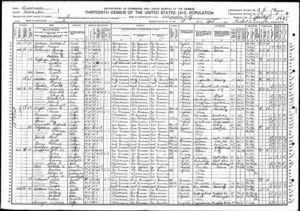Resolving Dead Ends in Trees, Part One
Editor’s Note: Thanks to our guest blogger, Karen Meyer, currently serving as an Area Temple and Family History Consultant in the Scottsdale (AZ) Coordinating Council, for this blog post. In Part One, she outlines some common causes for dead ends in family trees and how to address them.
Problem #1: Too many Census Data Sheets for the same year.
One guest’s tree shows the following records:
- Michael Lally arriving in 1900 with his wife Elizabeth from the U.K.
- Michael Lally arriving in 1911 with his wife Elizabeth from the U.K.
- M Lally with arriving in 1906 with wife from UK (wife name unknown)
If you have too many census data sheets or immigration records for the same year, the can’t all be for one person. In this example, you might be tracking hints for more than one Michael Lally. You can fix this by analyzing your records and checking what was said to the enumerator for each census as to when they arrived. The one immigration record should match the census record, if he came before 1900 (or 1900, 1910, 1920). Use the census data that most closely matches the arrival information in the immigration records.
In looking for this Michael Lally, the guest kept anything that looked like it would be a match until he could decide later. The problem: having it listed in his Ancestry tree caused multiple hints to follow the data attached to the tree. He was tracking for times when his ancestor Michael Lally was still in the UK. He needed to delete all the attached info for USA arrivals and census data that showed him in the USA, when it was verified he was still in England. Remember, if you Google your own name, you will see that even in your own city, there are probably lots of people with your name. Don’t become a bad data magnet by keeping these extra records in your tree; that’s what the Ancestry Shoebox is for. It’s a safe place where you can go back and find your evidence, and then enter it into your tree when you are doubly sure of its value.
Problem #2: There’s no data …
The guest in this scenario reported that he couldn’t find any data. This dead end was tricky. The ancestor had a  birth date of 1779 in Knoxville, Knox, Tennessee, with a death date of “about 1812” in Missouri. I often become suspicious when someone types “about” — that’s usually a guess. It could be legit if the notes indicate that the person was not found on the 1820 census in any state (just in case they moved), and not Missouri specifically. So I was concerned because Tennessee only became a state in 1796. Aha! So looked on a map from the 1790s and saw that North Carolina was the nearest existing state holding records right before Tennessee became a state.
birth date of 1779 in Knoxville, Knox, Tennessee, with a death date of “about 1812” in Missouri. I often become suspicious when someone types “about” — that’s usually a guess. It could be legit if the notes indicate that the person was not found on the 1820 census in any state (just in case they moved), and not Missouri specifically. So I was concerned because Tennessee only became a state in 1796. Aha! So looked on a map from the 1790s and saw that North Carolina was the nearest existing state holding records right before Tennessee became a state.
You can find that information here:
https://simple.wikipedia.org/wiki/List_of_U.S._states_by_date_of_admission_to_the_Union
So instead of “no data” it was a case of incorrect data.
Problem #3: A date is wrong. 
A picture was noted on the back as “Thanksgiving 1923 – November 29” for the death date of an ancestor, but the information became a dead end. So it occurred to me that the wrong date might have been used for Thanksgiving. I went to www.timeanddate.com and found that the person really died on Thanksgiving, November 22, 1923. When I entered that date, records for ensuing generations started populating for several generations.
Problem 4: Typing “helpful” spouse information that isn’t really helpful.
In this example, we see James John Miller with no recorded parents. In the tree, he is married to Sarah Miller.

The argument I usually hear is, “She IS Mrs. James Miller. If I don’t know the maiden name, I put in the married name.”
A database such as FamilySearch or Ancestry looks for blanks to fill. It’s smart enough to sort the questions and put the information right in your hands to place into the blank. However, if that blank is already filled, the database responds as if to say, “She doesn’t need my help. The field is already filled in, so let’s move on …”
The database does an amazing job when you enter just what you are supposed to in the fields. It’s constantly looking for hints for you. Let it rest easy by entering only what the field requires. The database’s objective is to fill the blank space, so it gives you hints to choose from.
In this scenario, you would temporarily delete her name. Then you would go to the husband’s profile and do a bridge search (log in to all your partner access accounts and minimize them), looking for a marriage certificate in the same county where the first child was born. That is where I would start.





